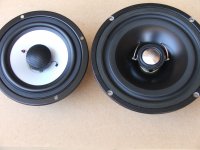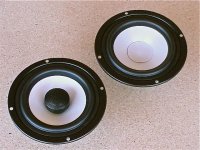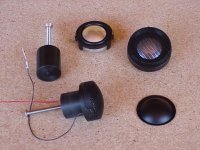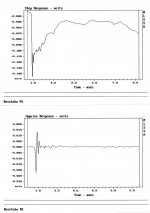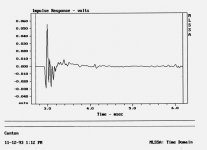Hi,
I'm trying to learn some stuff here, having just discovered how amazing a nice speaker setup can be and I'm out to experiment with some stuff.
From what I gather so far, the advantages of "full range" drivers that people enjoy should be able to be accomplished with axial speakers. Is this correct, or if not, what are the differences in how they are housed, placed, etc? I guess they still have crossovers, but they seem to be the "pinpoint source" that people like for image and so on.
I'm willing to hear it all.
I'm trying to learn some stuff here, having just discovered how amazing a nice speaker setup can be and I'm out to experiment with some stuff.
From what I gather so far, the advantages of "full range" drivers that people enjoy should be able to be accomplished with axial speakers. Is this correct, or if not, what are the differences in how they are housed, placed, etc? I guess they still have crossovers, but they seem to be the "pinpoint source" that people like for image and so on.
I'm willing to hear it all.
Hi,
I'm trying to learn some stuff here, having just discovered how amazing a nice speaker setup can be and I'm out to experiment with some stuff.
From what I gather so far, the advantages of "full range" drivers that people enjoy should be able to be accomplished with axial speakers. Is this correct, or if not, what are the differences in how they are housed, placed, etc? I guess they still have crossovers, but they seem to be the "pinpoint source" that people like for image and so on.
I'm willing to hear it all.
Most coaxial speakers approximate a point source, but that doesn't make them a fullrange single driver loudspeakers. To tell you the truth a single driver with a whizzer cone is actually a 2-way driver, as the crossover is mechanical rather that electrical. It gets pretty confusing with the addition of bending wave drivers, etc.
Best Regards,
TerryO
\To tell you the truth a single driver with a whizzer cone is actually a 2-way driver, as the crossover is mechanical rather that electrical.
DGP. To be honest, I've often wondered if a horn/line/port/etc loaded driver is still a truly 1-way system, since the loading offers augmentation that isn't inherent to and not necessarily "in phase" with the driver.
DGP. To be honest, I've often wondered if a horn/line/port/etc loaded driver is still a truly 1-way system, since the loading offers augmentation that isn't inherent to and not necessarily "in phase" with the driver.
The bass is augmented by the cabinet design, but the output is still provided by the driver. It can, as you have apprenended, get pretty confusing, although for our speaker contest a fullrange speaker is basically defined as one without an electrical crossover.
Best Regards,
TerryO
So what is the most important factor in this kind of design? Is it having a single driver only, or no crossovers or what? And why are these factors so important? I guess I'm interested in what we are looking for (listening for) in this kind of design and what makes it worth the effort.
Ron
Ron
So what is the most important factor in this kind of design? Is it having a single driver only, or no crossovers or what? And why are these factors so important? I guess I'm interested in what we are looking for (listening for) in this kind of design and what makes it worth the effort.
Ron
The most important factor, is getting a really good driver. One that covers the entire range (almost).
If you only have a single driver to begin with then why would you need a crossover?
You can do a full range setup very economically, no need to invest heavily.
Hi Ron,So what is the most important factor in this kind of design? Is it having a single driver only, or no crossovers or what? And why are these factors so important? I guess I'm interested in what we are looking for (listening for) in this kind of design and what makes it worth the effort.
Ron
A single driver does give you a single point source, it has no crossover (especially important in the midrange/vocal frequencies) that can introduce timing/phase problems. The ability to reproduce the music is dependant on the driver/enclosure combination as well as the need for synergy with the amplifier. If these are optimized the results can be quite beguiling. More than one very experienced speaker designer/builder has been astounded by how beautiful the music sounds, through a fullrange/ single driver type system.
I might add that while crossover design for a multi way speaker certainly isn't easy when seeking excellent results, a "fullrange" (actually, extended range is more accurate) speaker design is quite a bit of work itself, as it tends to be a holistic approach. Just the same, it certainly isn't due to a lack of skill that people have taken the seemingly simple "fullrange" approach, but rather a quest for the best sound.
Best Regards,
TerryO
Do we need a Coaxial speaker forum at DIYAUDIO?
I think that this forum in DIY audio should be renamed Full range and Coaxial as is the best place for this discussion, or do we need a Coaxial speaker forum?
I strongly agree that the speaker crossover is the hardest part of loud speaker design. It also leads to a significant impairment on the sound, even when done well, for this reason many like full range speakers.
I have yet to see third party measurements on dynamic full range drivers that are good enough up to the limits of my hearing which in my late thirties is still working up to 17kHz. I didnt buy the german speaker building magazeen , rather read it in the train station, but the mesaurements of the Mark Audio drivers showing good performance until resonance at 11Khz which is still within my hearing range.
With dynamic speakers, paper and felt based full range drivers appealed to me most, as I find the properties of these felts are amasing for thier wide bandwith and controled resonances. All this said a 3 Inch driver is possibly too big to go high enough for my requirements, as I should ideally like an octave of smooth responce beyond my hearing, maybe some one can develop a nice 2 Inch cone, so people can do without ribbon or dome tweeter, but we will start to suffer from the beaming like the old Electrostatics at the high frequancies above 10Khz, but at that frequancy only the young and lucky will find the beeming anoying I would hope.
I think since none of the 2-3 Inches speakers I have seen specifications on, could play music down from 30KHz down to 300 Hz without significant resonances contributing to the illusion of flat response at the high end, and definitely not dance party volumes, then the coaxial compromise is as valid and reasonable aproach, for many use cases and a coaxial speaker and has no natural place in DIY audio forums, its benifits are similar to Electrostatic and full range speakers, but coaxial speakers are a better compromise for volume, than either the cheaper or more expensive solutions.
I once had a very old pair of Castle Richmond 3 speakers (I guess mid 1980's). These had a 4 Inch bass driver. They had the best stereo imaging that I had heard. One day the tweeter broke, (low power amps going into hard clipping) with out a cross over or tweeter and realised these speakers imaged even better, though less treble, and a little boost helped. I rearly liked these speakers, found a pair of tweeters for sale surprisingly, and enjoyed them a little longer, I was considering improving the cross over, but the bass in such a small speaker could not suit all my music, so I slowly killed the drive units in the bass reflex box they came with. I tried some solutions, but time and money got in the way. (mid 1990's)
Next I got a old pair of Quad ESL 57 (Again mid 1990's), a friend had some mid 90's Tannoy 607? speakers. Both had very impressive imaging compared to conventional multi way, but the ESL57 only worked for one place equidistant from the speakers, when in this position, the Quad ESL 57 clearly sounded better, making the Tannoys sound as hey had resonances in the high frequancey driver. The Co-axials where much better party speakers.
I looked at a lot of specifications and decided their are so many interesting trade offs in speakers.
The current generation of full range speakers that I could be experimenting for so long, and price was not nessisarily related to quality, and that my use would definately be enhanced in the Bass department, I decided to buy well reviewed and analysied Electrostatic loudspeaker with third party measurement. Though I might try using some coaxial or full range drivers after my other Hifi experiments.
People with medium budgets wanting more general perpose speakers I think should investigate coaxial speakers, unfortunately not many models exist
For the most budget concious, I suspect full range speakers can potenaitlly provide at limited volumes the best sound quality, this can be improved and made more robust, with augmented bass in an active system can with less design and test equiment, produce an effect rivaling more expensive systems and have excellent spacial characteristics.
Coaxial speaker look very interesting to me, and might make a great general purpose speaker.
Regards
Owen
I think that this forum in DIY audio should be renamed Full range and Coaxial as is the best place for this discussion, or do we need a Coaxial speaker forum?
I strongly agree that the speaker crossover is the hardest part of loud speaker design. It also leads to a significant impairment on the sound, even when done well, for this reason many like full range speakers.
I have yet to see third party measurements on dynamic full range drivers that are good enough up to the limits of my hearing which in my late thirties is still working up to 17kHz. I didnt buy the german speaker building magazeen , rather read it in the train station, but the mesaurements of the Mark Audio drivers showing good performance until resonance at 11Khz which is still within my hearing range.
With dynamic speakers, paper and felt based full range drivers appealed to me most, as I find the properties of these felts are amasing for thier wide bandwith and controled resonances. All this said a 3 Inch driver is possibly too big to go high enough for my requirements, as I should ideally like an octave of smooth responce beyond my hearing, maybe some one can develop a nice 2 Inch cone, so people can do without ribbon or dome tweeter, but we will start to suffer from the beaming like the old Electrostatics at the high frequancies above 10Khz, but at that frequancy only the young and lucky will find the beeming anoying I would hope.
I think since none of the 2-3 Inches speakers I have seen specifications on, could play music down from 30KHz down to 300 Hz without significant resonances contributing to the illusion of flat response at the high end, and definitely not dance party volumes, then the coaxial compromise is as valid and reasonable aproach, for many use cases and a coaxial speaker and has no natural place in DIY audio forums, its benifits are similar to Electrostatic and full range speakers, but coaxial speakers are a better compromise for volume, than either the cheaper or more expensive solutions.
I once had a very old pair of Castle Richmond 3 speakers (I guess mid 1980's). These had a 4 Inch bass driver. They had the best stereo imaging that I had heard. One day the tweeter broke, (low power amps going into hard clipping) with out a cross over or tweeter and realised these speakers imaged even better, though less treble, and a little boost helped. I rearly liked these speakers, found a pair of tweeters for sale surprisingly, and enjoyed them a little longer, I was considering improving the cross over, but the bass in such a small speaker could not suit all my music, so I slowly killed the drive units in the bass reflex box they came with. I tried some solutions, but time and money got in the way. (mid 1990's)
Next I got a old pair of Quad ESL 57 (Again mid 1990's), a friend had some mid 90's Tannoy 607? speakers. Both had very impressive imaging compared to conventional multi way, but the ESL57 only worked for one place equidistant from the speakers, when in this position, the Quad ESL 57 clearly sounded better, making the Tannoys sound as hey had resonances in the high frequancey driver. The Co-axials where much better party speakers.
I looked at a lot of specifications and decided their are so many interesting trade offs in speakers.
The current generation of full range speakers that I could be experimenting for so long, and price was not nessisarily related to quality, and that my use would definately be enhanced in the Bass department, I decided to buy well reviewed and analysied Electrostatic loudspeaker with third party measurement. Though I might try using some coaxial or full range drivers after my other Hifi experiments.
People with medium budgets wanting more general perpose speakers I think should investigate coaxial speakers, unfortunately not many models exist
For the most budget concious, I suspect full range speakers can potenaitlly provide at limited volumes the best sound quality, this can be improved and made more robust, with augmented bass in an active system can with less design and test equiment, produce an effect rivaling more expensive systems and have excellent spacial characteristics.
Coaxial speaker look very interesting to me, and might make a great general purpose speaker.
Regards
Owen
Interesting posts. Actually, my problem is opposite of Owen's. My hearing begins to fall off at about 5 and ends at 11K. Human hearing is a strange thing, though, and your brain adjusts for losses. If I boost highs too much, it actually can get annoying. Anyway, if my hearing ends at 10 khz or so, can I be less selective in choosing a FR speaker? I can use an EQ to make up for my loss up to that point. In spite of my high freq limitations, I'm pretty aware of image and other sound issues and I like good, smooth bass.I have yet to see third party measurements on dynamic full range drivers that are good enough up to the limits of my hearing which in my late thirties is still working up to 17kHz.
Owen
I really like the idea of a single driver system for the simplicity. I'm kind of a "simplest design is the best design" sort of guy, especially if it promises to give a superior result as well. Image, sound stage is a pretty important factor to me, if that's the right term to use. I'm very new to the nuts and bolts of this stuff.
I would love to see suggestions on driver selection, and also baffle arrangements (not too compex). Maybe I don't even need to be too concerned with coaxials with my hearing deficiency, if I can find a suitable single with the right characteristics. I have no objection to them though. I love a lot of good, smooth bass, so the larger the better for me even though I don't play really loud (my wife may disagree with that. She can can hear a butterfly down the street it seems. It's actually quite a curse.). As I say, I'm willing to EQ it. I should mention that my room is quite large and I kind of like the idea of open baffle if it would work. Is it possible to get a 15" that has adequate range and characteristics? Probably not, huh?
Thanks,
Ron
FR vers. Coaxial
Hello,
make a step response than you will see the difference,
every "more way" has a crossover, different acceleration, different
membran material, some times different systems etc.
with enough listening experience our ear brain can get it, thats why i prefer
fullrange, some critics about FR are less important in comparison
to the problems of "more ways", for example beaming:
due to today's furnishing (leather, parquet, shutters, glass),
I consider a strong direct sound something to be prefered.
look here Manger Basstuba step response and impuls
and a superb canton 3 way impuls, you see the impuls is destroyed by the three way.
Hello,
make a step response than you will see the difference,
every "more way" has a crossover, different acceleration, different
membran material, some times different systems etc.
with enough listening experience our ear brain can get it, thats why i prefer
fullrange, some critics about FR are less important in comparison
to the problems of "more ways", for example beaming:
due to today's furnishing (leather, parquet, shutters, glass),
I consider a strong direct sound something to be prefered.
look here Manger Basstuba step response and impuls
and a superb canton 3 way impuls, you see the impuls is destroyed by the three way.
Attachments
To the original question, I agree with TerryO, a coaxial driver would not be considered a full-range driver because it needs a crossover.
MJK’s Jordan JX92S OB with a Goldwood GW-1858 Woofer in an H Frame meets your criteria:
Jordan JX92S OB with a Goldwood GW-1858 Woofer in an H Frame Project
I really like the idea of a single driver system for the simplicity. I'm kind of a "simplest design is the best design" sort of guy, especially if it promises to give a superior result as well.
I should mention that my room is quite large and I kind of like the idea of open baffle if it would work. Is it possible to get a 15" that has adequate range and characteristics? Probably not, huh?
MJK’s Jordan JX92S OB with a Goldwood GW-1858 Woofer in an H Frame meets your criteria:
Jordan JX92S OB with a Goldwood GW-1858 Woofer in an H Frame Project
Last edited:
I have 20KHz capable ears and use full range drivers although I tend to roll off extreme treble as almost all audio is mastered very hot in the trebel presumably because most people involved in the production of it have damaged hearing. As for coax drivers they are fullrange drivers as they produce the full freq range, however it's better to think of them as not full range as they have more in common with multi way speakers in terms of crossover than full range.
Well, that''s interesting! Does this kind of arrangement defeat the goal of a single point source for good image and stage? I hear so many people say that is one of the main reasons for going to a single driver setup and I do want to strive for that goal (image and stage) and still have punch and strength to the sound. Is all this even possible on a budget???To the original question, I agree with TerryO, a coaxial driver would not be considered a full-range driver because it needs a crossover.
MJK’s Jordan JX92S OB with a Goldwood GW-1858 Woofer in an H Frame meets your criteria:
Jordan JX92S OB with a Goldwood GW-1858 Woofer in an H Frame Project
Would mounting each driver right next to each other work better for image, or would there be interference issues, or do you think it even matters? Baffle size isn't a real important factor here within reasonable limits. I'm also not too concerned about semantics, but I do want to learn what you guys are talking about and use proper terminology.
That's an interesting observation . My son-in-law has a high-end recording studio and produces, records and masters for a living. I'll have to get his take on that!I have 20KHz capable ears and use full range drivers although I tend to roll off extreme treble as almost all audio is mastered very hot in the trebel presumably because most people involved in the production of it have damaged hearing .
BTW, I can't get good DIY advice from him; if it doesn't cost in the four figures, it isn't worth spit....You ought to see his stuff.
Last edited:
Well, that''s interesting! Does this kind of arrangement defeat the goal of a single point source for good image and stage? I hear so many people say that is one of the main reasons for going to a single driver setup and I do want to strive for that goal (image and stage) and still have punch and strength to the sound. Is all this even possible on a budget???
This arrangement is a compromise like all designs, but at the frequencies that these cross over, there is much less that is compromised than, say a conventional 2-way speaker. You retain nearly all of the point source imaging and clarity while being able to produce a deep bass fundamental with enough power to remain entirely convincing.
Would mounting each driver right next to each other work better for image, or would there be interference issues, or do you think it even matters? Baffle size isn't a real important factor here within reasonable limits. I'm also not too concerned about semantics, but I do want to learn what you guys are talking about and use proper terminology.
At the frequency of the crossover there is little to be gained by tightly grouping the drivers and enough to be lost, that Martin's setup makes a lot of sense. BTW: Baffle size is fairly important as it will determine where you need to begin to attenuate the main driver to account for baffle-step losses.This is determined "primarily" by the width of the baffle that the main driver is located, so baffle size is extremely important. It's not nearly as easy, or as haphazard, as it looks.
Like I said, all speaker designs are the result of compromises. In this case, Martin certainly chose wisely.
Best Regards,
TerryO
Last edited:
I agree with everything TerryO said above. I would add that it would be unwise for you to try and improve on MJK's design. Either build it as is, or find another project. The design is well thought out and executed, and appears to me to be exactly what you were asking for; reasonable size, easy build, open baffle, full-range coherence, large bass driver. You should go for it!
There doesn't seem to be an argument when it comes to accepting "helper tweeters" in this forum so why not add coaxials to the list. As mentioned earlier, most of the sound the coaxial produces would be cabinet dependant as opposed to cross-over dependant (as full rangers are), so I don't think they qualify as multi-driver anyhow.
Finally, a forum to figure out what to do with my 4 12" co-axials. They are vintage (68-72 or so), refoamed, reclamation drive units from cabinets used at Churchill Downs.
Very heavy well built pa speakers from rather large, un- ported cabs. If i figure out the foto posting thingie I'll post pics.
Finally, a forum to figure out what to do with my 4 12" co-axials. They are vintage (68-72 or so), refoamed, reclamation drive units from cabinets used at Churchill Downs.
Very heavy well built pa speakers from rather large, un- ported cabs. If i figure out the foto posting thingie I'll post pics.
- Status
- This old topic is closed. If you want to reopen this topic, contact a moderator using the "Report Post" button.
- Home
- Loudspeakers
- Full Range
- Are coaxial/triaxial speakers considered "Full Range"?
